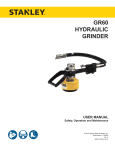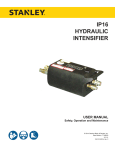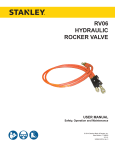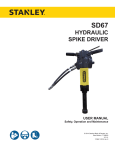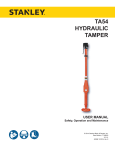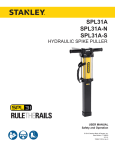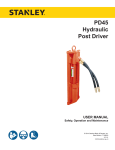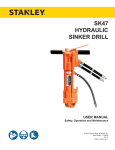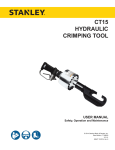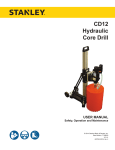Download TOOL EXCHANGE VALVE
Transcript
TOOL EXCHANGE VALVE USER MANUAL Safety, Operation and Maintenance © 2014 Stanley Black & Decker, Inc. New Britain, CT 06053 U.S.A. 69723 10/2014 Ver. 3 TABLE OF CONTENTS SAFETY SYMBOLS...................................................................................................................................................4 SAFETY PRECAUTIONS...........................................................................................................................................5 HOSE TYPES.............................................................................................................................................................6 HTMA REQUIREMENTS............................................................................................................................................7 OPERATION...............................................................................................................................................................8 SPECIFICATIONS....................................................................................................................................................10 TOOL EXCHANGE PARTS ILLUSTRATION AND LIST—HANDHELD VERSION P/N 67005................................ 11 TOOL EXCHANGE PARTS ILLUSTRATION AND LIST—RAILROAD VERSION P/N 69722................................. 12 IMPORTANT To fill out a Product Warranty Validation form, and for information on your warranty, visit Stanleyhydraulics.com and select the Company tab, Warranty. (NOTE: The warranty Validation record must be submitted to validate the warranty). SERVICING: This manual contains safety, operation, and routine maintenance instructions. Stanley Hydraulic Tools recommends that servicing of hydraulic tools, other than routine maintenance, must be performed by an authorized and certified dealer. Please read the following warning. WARNING SERIOUS INJURY OR DEATH COULD RESULT FROM THE IMPROPER REPAIR OR SERVICE OF THIS TOOL. REPAIRS AND / OR SERVICE TO THIS TOOL MUST ONLY BE DONE BY AN AUTHORIZED AND CERTIFIED DEALER. For the nearest authorized and certified dealer, call Stanley Hydraulic Tools at the number listed on the back of this manual and ask for a Customer Service Representative. Tool Exchange Valve User Manual ◄ 3 SAFETY SYMBOLS Safety symbols and signal words, as shown below, are used to emphasize all operator, maintenance and repair actions which, if not strictly followed, could result in a life-threatening situation, bodily injury or damage to equipment. This is the safety alert symbol. It is used to alert you to potential personal injury hazards. Obey all safety messages that follow this symbol to avoid possible injury or death. DANGER This safety alert and signal word indicate an imminently hazardous situation which, if not avoided, will result in death or serious injury. WARNING This safety alert and signal word indicate a potentially hazardous situation which, if not avoided, could result in death or serious injury. CAUTION This safety alert and signal word indicate a potentially hazardous situation which, if not avoided, could result in death or serious injury. CAUTION This signal word indicates a potentially hazardous situation which, if not avoided, may result in property damage. NOTICE This signal word indicates a situation which, if not avoided, will result in damage to the equipment. IMPORTANT This signal word indicates a situation which, if not avoided, may result in damage to the equipment. Always observe safety symbols. They are included for your safety and for the protection of the tool. LOCAL SAFETY REGULATIONS Enter any local safety regulations here. Keep these instructions in an area accessible to the operator and maintenance personnel. 4 ► Tool Exchange Valve User Manual SAFETY PRECAUTIONS Tool operators and maintenance personnel must always comply with the safety precautions given in this manual and on the stickers and tags attached to the tool and hose. These safety precautions are given for your safety. Review them carefully before operating the tool and before performing general maintenance or repairs. Supervising personnel should develop additional precautions relating to the specific work area and local safety regulations. If so, place the added precautions in the space provided on the previous page. This valve will provide safe and dependable service if operated in accordance with the instructions given in this manual. Read and understand this manual and any stickers and tags attached to the tool and hose before operation. Failure to do so could result in personal injury or equipment damage. • The operator must start in a work area without bystanders. Flying debris can cause serious injury. • Do not operate the valve unless thoroughly trained or under the supervision of an instructor. Establish a training program for all operators to ensure safe operation. • Always wear safety equipment such as goggles, ear and head protection, and safety shoes at all times when operating the valve. Use gloves and aprons when necessary. • The operator must be familiar with all prohibited work areas such as excessive slopes and dangerous terrain conditions. • Maintain proper footing and balance at all times. • Do not inspect or clean the valve while the hydraulic power source is connected. Accidental engagement can cause serious injury. • Do not operate the valve at oil temperatures above 140°F/60°C. Operation at higher temperatures can cause higher than normal temperatures at the valve which can result in operator discomfort. • Do not operate a damaged, improperly adjusted, or incompletely assembled valve. • Always use accessories that conform to the specifications given in the OPERATION section of this manual. • When working near electrical conductors, always assume that all conductors are energized and that insulation, clothing and hoses can conduct electricity. Use hose labeled and certified as non-conductive. • To avoid personal injury or equipment damage, all valve repair, maintenance and service must only be performed by authorized and properly trained personnel. • Do not carry the valve by hoses. Tool Exchange Valve User Manual ◄ 5 HOSE TYPES The rated working pressure of the hydraulic hose must be equal to or higher than the relief valve setting on the hydraulic system. There are three types of hydraulic hose that meet this requirement and are authorized for use with Stanley Hydraulic Tools. They are: Certified non-conductive — constructed of thermoplastic or synthetic rubber inner tube, synthetic fiber braid reinforcement, and weather resistant thermoplastic or synthetic rubber cover. Hose labeled certified nonconductive is the only hose authorized for use near electrical conductors. Wire-braided (conductive) — constructed of synthetic rubber inner tube, single or double wire braid reinforcement, and weather resistant synthetic rubber cover. This hose is conductive and must never be used near electrical conductors. Fabric-braided (not certified or labeled non-conductive) — constructed of thermoplastic or synthetic rubber inner tube, synthetic fiber braid reinforcement, and weather resistant thermoplastic or synthetic rubber cover. This hose is not certified non-conductive and must never be used near electrical conductors. HOSE SAFETY TAGS To help ensure your safety, the following DANGER tags are attached to all hose purchased from Stanley Hydraulic Tools. DO NOT REMOVE THESE TAGS. If the information on a tag is illegible because of wear or damage, replace the tag immediately. A new tag may be obtained from your Stanley Distributor. D A N G E R D A N G E R 1. FAILURE TO USE HYDRAULIC HOSE LABELED AND CERTIFIED AS NON-CONDUCTIVE WHEN USING HYDRAULIC TOOLS ON OR NEAR ELECTRIC LINES MAY RESULT IN DEATH OR SERIOUS INJURY. FOR PROPER AND SAFE OPERATION MAKE SURE THAT YOU HAVE BEEN PROPERLY TRAINED IN CORRECT PROCEDURES REQUIRED FOR WORK ON OR AROUND ELECTRIC LINES. 2. BEFORE USING HYDRAULIC HOSE LABELED AND CERTIFIED AS NON-CONDUCTIVE ON OR NEAR ELECTRIC LINES. WIPE THE ENTIRE LENGTH OF THE HOSE AND FITTING WITH A CLEAN DRY ABSORBENT CLOTH TO REMOVE DIRT AND MOISTURE AND TEST HOSE FOR MAXIMUM ALLOWABLE CURRENT LEAKAGE IN ACCORDANCE WITH SAFETY DEPARTMENT INSTRUCTIONS. 3. DO NOT EXCEED HOSE WORKING PRESSURE OR ABUSE HOSE. IMPROPER USE OR HANDLING OF HOSE COULD RESULT IN BURST OR OTHER HOSE FAILURE. KEEP HOSE AS FAR AWAY AS POSSIBLE FROM BODY AND DO NOT PERMIT DIRECT CONTACT DURING USE. CONTACT AT THE BURST CAN CAUSE BODILY INJECTION AND SEVERE PERSONAL INJURY. 4. HANDLE AND ROUTE HOSE CAREFULLY TO AVOID KINKING, ABRASION, CUTTING, OR CONTACT WITH HIGH TEMPERATURE SURFACES. DO NOT USE IF KINKED. DO NOT USE HOSE TO PULL OR LIFT TOOLS, POWER UNITS, ETC. 5. CHECK ENTIRE HOSE FOR CUTS CRACKS LEAKS ABRASIONS, BULGES, OR DAMAGE TO COUPLINGS IF ANY OF THESE CONDITIONS EXIST, REPLACE THE HOSE IMMEDIATELY. NEVER USE TAPE OR ANY DEVICE TO ATTEMPT TO MEND THE HOSE. 6. AFTER EACH USE STORE IN A CLEAN DRY AREA. SEE OTHER SIDE SIDE 1 SEE OTHER SIDE (Shown smaller than actual size) DO NOT REMOVE THIS TAG DO NOT REMOVE THIS TAG THE TAG SHOWN BELOW IS ATTACHED TO “CERTIFIED NON-CONDUCTIVE” HOSE SIDE 2 D A N G E R D A N G E R 1. DO NOT USE THIS HYDRAULIC HOSE ON OR NEAR ELECTRIC LINES. THIS HOSE IS NOT LABELED OR CERTIFIED AS NON-CONDUCTIVE. USING THIS HOSE ON OR NEAR ELECTRICAL LINES MAY RESULT IN DEATH OR SERIOUS INJURY. 5. CHECK ENTIRE HOSE FOR CUTS CRACKS LEAKS ABRASIONS, BULGES, OR DAMAGE TO COUPLINGS IF ANY OF THESE CONDITIONS EXIST, REPLACE THE HOSE IMMEDIATELY. NEVER USE TAPE OR ANY DEVICE TO ATTEMPT TO MEND THE HOSE. 2. FOR PROPER AND SAFE OPERATION MAKE SURE THAT YOU HAVE BEEN PROPERLY TRAINED IN CORRECT PROCEDURES REQUIRED FOR WORK ON OR AROUND ELECTRIC LINES. 6. AFTER EACH USE STORE IN A CLEAN DRY AREA. 3. DO NOT EXCEED HOSE WORKING PRESSURE OR ABUSE HOSE. IMPROPER USE OR HANDLING OF HOSE COULD RESULT IN BURST OR OTHER HOSE FAILURE. KEEP HOSE AS FAR AWAY AS POSSIBLE FROM BODY AND DO NOT PERMIT DIRECT CONTACT DURING USE. CONTACT AT THE BURST CAN CAUSE BODILY INJECTION AND SEVERE PERSONAL INJURY. 4. HANDLE AND ROUTE HOSE CAREFULLY TO AVOID KINKING, CUTTING, OR CONTACT WITH HIGH TEMPERATURE SURFACES. DO NOT USE IF KINKED. DO NOT USE HOSE TO PULL OR LIFT TOOLS, POWER UNITS, ETC. SEE OTHER SIDE SEE OTHER SIDE SIDE 1 SIDE 2 (Shown smaller than actual size) 6 ► Tool Exchange Valve User Manual DO NOT REMOVE THIS TAG DO NOT REMOVE THIS TAG THE TAG SHOWN BELOW IS ATTACHED TO “CONDUCTIVE” HOSE. HTMA / EHTMA REQUIREMENTS HTMA / EHTMA REQUIREMENTS HTMA HYDRAULIC SYSTEM REQUIREMENTS TYPE I Nominal Operating Pressure (at the power supply outlet) 4-6 gpm (15-23 lpm) 1500 psi (103 bar) TOOL TYPE TYPE II TYPE RR 7-9 gpm (26-34 lpm) 1500 psi (103 bar) 9-10.5 gpm (34-40 lpm) 1500 psi (103 bar) System relief valve setting (at the power supply outlet) 2100-2250 psi (145-155 bar) 2100-2250 psi (145-155 bar) 2200-2300 psi (152-159 bar) 2100-2250 psi (145-155 bar) Maximum back pressure (at tool end of the return hose) 250 psi (17 bar) 250 psi (17 bar) 250 psi (17 bar) 250 psi (17 bar) Measured at a max. fluid viscosity of: (at min. operating temperature) 400 ssu* 400 ssu* 400 ssu* 400 ssu* (82 centistokes) (82 centistokes) (82 centistokes) (82 centistokes) Temperature: Sufficient heat rejection capacity to limit max. fluid temperature to: (at max. expected ambient temperature) 140° F (60° C) Flow Range 140° F (60° C) 140° F (60° C) TYPE III 11-13 gpm (42-49 lpm) 1500 psi (103 bar) 140° F (60° C) 3 hp 5 hp 6 hp 7 hp Min. cooling capacity at a temperature (2.24 kW) (3.73 kW) (5.22 kW) (4.47 kW) difference of between ambient and fluid 40° F 40° F 40° F 40° F temps (22° C) (22° C) (22° C) (22° C) NOTE: Do not operate the tool at oil temperatures above 140° F (60° C). Operation at higher temperatures can cause operator discomfort at the tool. Filter Min. full-flow filtration Sized for flow of at least: (For cold temp. startup and max. dirt-holding capacity) 25 microns 30 gpm (114 lpm) Hydraulic fluid Petroleum based (premium grade, anti-wear, non-conductive) Viscosity (at min. and max. operating temps) 100-400 ssu* 25 microns 30 gpm (114 lpm) 25 microns 30 gpm (114 lpm) 100-400 ssu* 100-400 ssu* (20-82 centistokes) 25 microns 30 gpm (114 lpm) 100-400 ssu* NOTE: When choosing hydraulic fluid, the expected oil temperature extremes that will be experienced in service determine the most suitable temperature viscosity characteristics. Hydraulic fluids with a viscosity index over 140 will meet the requirements over a wide range of operating temperatures. *SSU = Saybolt Seconds Universal EHTMA HYDRAULIC SYSTEM REQUIREMENTS CLASSIFICATION B C D Nominal Operating Pressure (at the power supply outlet) 3.5-4.3 gpm (13.5-16.5 lpm) 1870 psi (129 bar) 4.7-5.8 gpm (18-22 lpm) 1500 psi (103 bar) 7.1-8.7 gpm (27-33 lpm) 1500 psi (103 bar) 9.5-11.6 gpm (36-44 lpm) 1500 psi (103 bar) 11.8-14.5 gpm (45-55 lpm) 1500 psi (103 bar) System relief valve setting (at the power supply outlet) 2495 psi (172 bar) 2000 psi (138 bar) 2000 psi (138 bar) 2000 psi (138 bar) 2000 psi (138 bar) Flow Range NOTE: These are general hydraulic system requirements. See tool specification page for tool specific requirements Tool Exchange Valve User Manual ◄ 7 OPERATION PRE-OPERATION PROCEDURES INSTALLATION Ensure that you have read and understand the safety instructions included in this manual before you operate the valve. The Tool Exchange Valve is intended to be installed between the tool and the end of the hydraulic hose. Check whether the valve is damaged. Check that all the parts are functioning correctly. Check that moving parts do not become stuck and are not damaged. DO NOT use the valve if damaged or defective parts are detected. Damaged or defective parts must be repaired by a qualified technician. Using a calibrated flow meter and pressure gauge, check that the hydraulic power source develops a flow of 4-10.5 gpm/15-40 lpm at 2000 psi/140 bar with a maximum relief pressure not to exceed 2500 psi/170 bar. POWER 8 ► Tool Exchange Valve User Manual ON OFF TOOL Connect the Tool Exchange Valve to the hydraulic power supply on the side of the valve labeled “Power” as shown below. Observe the flow indicators cast into the valve and stamped on the couplers to ensure that the flow is in the proper direction. Connect the Tool Exchange Valve to the tool on the side of the valve labeled “Tool” as shown below. Observe the flow indicators cast into the valve and stamped on the couplers to ensure that the flow is in the proper direction. OPERATION OPERATION The Tool Exchange Valve is intended to function as a momentary ON/OFF valve that, when plumbed between a tool and a hydraulic power supply, will allow the end user to change tools without having to turn off the hydraulic circuit. Shifting the Tool Exchange Valve’s spool to the ON position will allow the tool to function normally. The hydraulic oil will flow from the hydraulic power supply through the valve to the tool. Return oil will flow from the tool through the valve and back to the hydraulic power supply’s reservoir. Shifting the Tool Exchange Valve’s spool to the OFF position will disconnect the tool from the hydraulic power supply. This will allow the end user to remove the tool and attach an alternate tool. Shifting the Tool Exchange Valve’s spool to the ON position will allow the alternate tool to function normally. CAUTION With a constant flow (open center) hydraulic power supply, shifting the Tool Exchange Valve’s spool to the OFF position will force all the hydraulic flow through the system’s relief valve. This valve is intended for tool exchange only and should not be left in the OFF position for more than 30 seconds. Failure to heed this warning can result in seal failure, excessive heat, and damage to the tool and hydraulic power supply. The Tool Exchange Valve should not be used as a tool ON/OFF valve. Use Part Number 38632 In-Line Valve for those applications. STORAGE Replace any damaged or missing safety labels and tags before storing the tool. Clean, dry and lubricate moving parts before storing the tool. Store the tool in a clean, dry place. Tool Exchange Valve User Manual ◄ 9 SPECIFICATIONS Length..........................................................................................................................................3.000 inches/7.6 cm Width............................................................................................................................................1.500 inches/3.8 cm Height...........................................................................................................................................3.750 inches/9.5 cm System Type................................................................................................................................. HTMA Type I, II, RR Flow Range...............................................................................................................................4-10.5 gpm/15-40 lpm Operating Pressure........................................................................................................................... 2000 psi/140 bar Maximum Relief Pressure................................................................................................................. 2500 psi/170 bar Tool Porting.......................................................................................................................................... -8 SAE O-Ring EQUIPMENT PROTECTION & CARE NOTICE In addition to the Safety Precautions found in this manual, observe the following for equipment protection and care. • Make sure all couplers are wiped clean before connection. • Always store the valve in a clean dry space, safe from damage or pilferage. • Make sure the circuit PRESSURE hose (with male quick disconnect) is connected to the IN port. The circuit RETURN hose (with female quick disconnect) is connected to the opposite port. Do not reverse circuit flow. This can cause damage to internal seals. • Always replace hoses, couplings and other parts with replacement parts recommended by Stanley Hydraulic Tools. Supply hoses must have a minimum working pressure rating of 2500 psi/172 bar. 10 ► Tool Exchange Valve User Manual • Do not exceed the rated flow (see Specifications in this manual for correct flow rate and model number). Rapid failure of the internal seals may result. • Valve repair should be performed by experienced personnel only. • Make certain that the recommended relief valves are installed in the pressure side of the system. • Do not use the valve for applications for which it was not intended. TOOL EXCHANGE VALVE PARTS 8 4 9 3 2 6 7 5 10 11 1 5 4 TOOL EXCHANGE PARTS ILLUSTRATION AND LIST— HANDHELD VERSION P/N 67005 ITEM PART NO. QTY DESCRIPTION 1 00936 2 ADAPTER 2 01604 2 O-RING 3 01652 2 HOSE WHIP, 12" 4 03972 2 COUPLER, 3/8 FEMALE, 3/8 NPT FL FACE SET 03971 5 03973 2 COUPLER, 3/8 MALE, 3/8 NPT FL FACE SET 03971 6 07224 2 BACK-UP RING 7 07626 2 O-RING 8 56747 2 SEAL WIPER 9 56749 2 SEAL CAP 10 67008 1 VALVE SPOOL 11 69721 1 INLINE CALVE BODY ASSY Tool Exchange Valve User Manual ◄ 11 TOOL EXCHANGE VALVE PARTS 6 7 8 4 1 2 3 9 10 5 5 4 TOOL EXCHANGE PARTS ILLUSTRATION AND LIST— RAILROAD VERSION P/N 69722 12 ► Tool Exchange Valve User Manual ITEM PART NO. QTY DESCRIPTION 1 01604 2 O-RING 2 07224 2 BACK-UP RING 3 07626 2 O-RING 4 47436 2 COUPLER, 3/8 FEMALE, 3/8 NPT FL FACE SET 47438 5 47437 2 COUPLER, 3/8 MALE, 3/8 NPT FL FACE SET 47438 6 56747 2 SEAL WIPER 7 56749 2 SEAL CAP 8 66727 4 HOSE ASSY 9 67008 1 VALVE SPOOL 10 69721 1 TOOL EXCHANGE VALVE Stanley Hydraulic Tools 3810 SE Naef Road Milwaukie, Oregon 97267-5698 USA (503) 659-5660 / Fax (503) 652-1780 www.stanleyhydraulics.com














